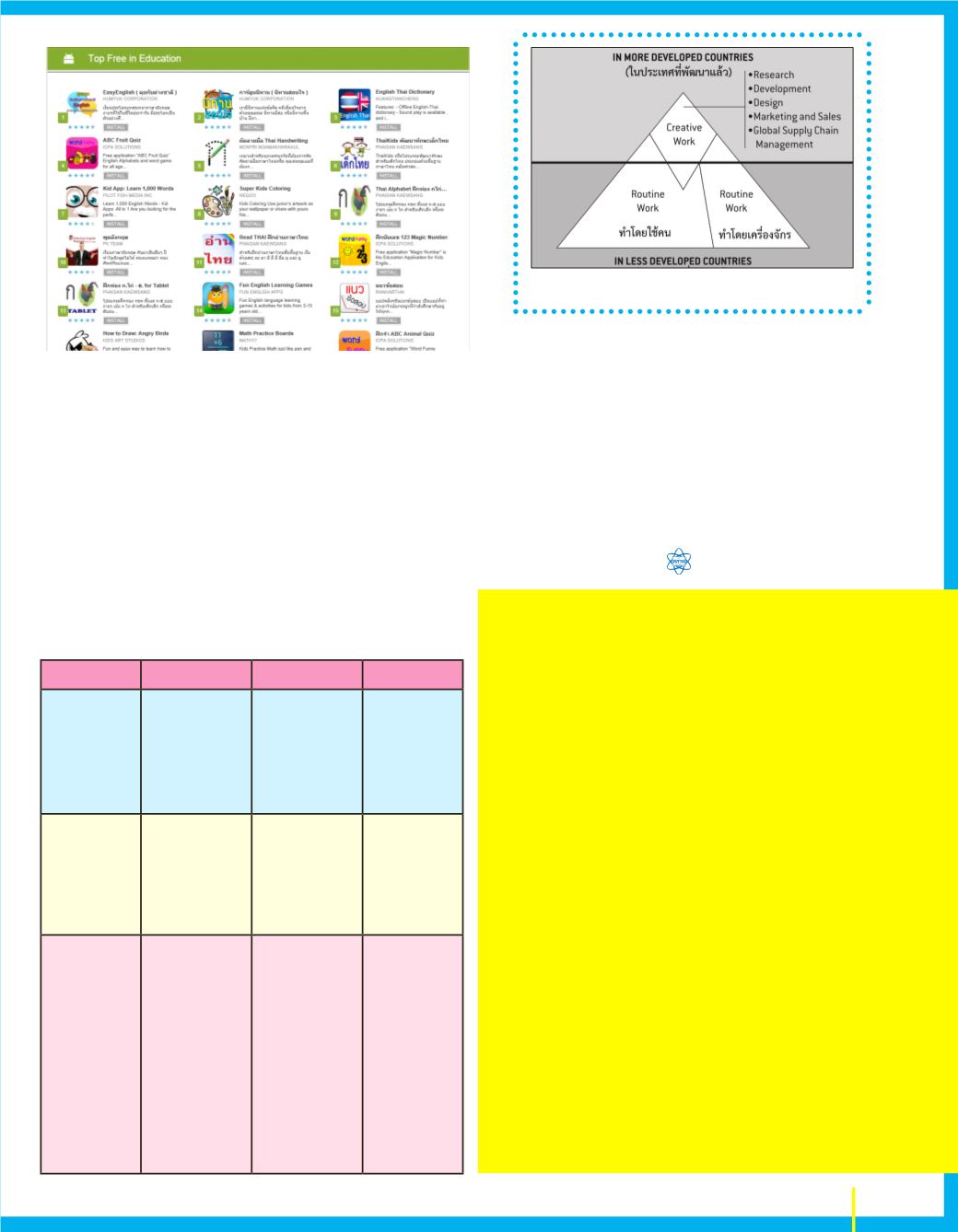

21
ปีที่ 41 ฉบับที่ 181 มีนาคม - เมษายน 2556
บรรณานุกรม
Burke, L. E., Styn, M. A., Sereika, S. M., Conroy, M. B., Ye, L., Glanz, K., Sevick, M. A.
& Ewing, L. J. (2012). Using mHealth technology to enhance self-monitoring for
weight loss: A randomized trial.
American Journal of Preventive Medicine, 43,
20-26.
Dekhane, S. & Tsoi, M. Y. (2012). Designing a mobile application for conceptual
understanding: Integrating learning theory with organic chemistry learning needs.
International Journal of Mobile and Blended Learning, 4
, 34-52.
Dimaggio, P., Hagittai, E., Neuman, W. R. & Robinson, J. P. (2001). Social implications
of the internet.
Annual Review of Sociology, 27
, 307-336.
Goran, M. I. & Reynolds, K. (2005). Interactive multimedia for promoting physical
activity (IMPACT) in children.
Obesity Research
,
13
, 762-771.
Intille, S. S., Kukla, C., Farzanfar, R. & Bakr, W. (2003). Just-in-time technology to
encourage incremental, dietary behavior change.
AMIA Annual Symposium
Proceedings., 2003
, 874.
Miniwatts Marketing Group. (2012). Internet world stats: usage and population statistics.
Retrieved January 22, 2013, from
http://www.internetworldstats.com/stats.htmMorris, N. P., Ramsay, L. & Chauhan, V. (2012). Can a tablet device alter undergradu-
ate science students’ study behavior and use of technology?
Advances in
Physiology Education, 36
, 97-107.
Naidu, S. (2006).
E-learning: A guidebook of principles, procedures and practices
.
New Delhi: Commonwealth Education Media Center for Asia.
Pingdom. (2013). Internet 2012 in numbers . Retrieved January 22, 2013, from
http://royal.pingdom.com/2013/01/16/internet-2012-in-numbersTrilling, B. & Fadel, C. (2009).
21st Century Skills: Learning for life in our times
. San
Francisco: Jossey-Bass A Wiley Imprint.
ภาพที่ 2 แสดงตัวอย่างของ application ที่สามารถ download มาใช้ได้ฟรีจากอินเทอร์เน็ต
ภาพที่ 3 อนาคตของงานในศตวรรษที่ 21
ที่มา : ดัดแปลงจาก National Center on Education and the Economy, 2007.
(ในประเทศที่พัฒนาน้อย)
ที่มา : ดัดแปลงจาก Trilling, B. & Fadel, C. 2009. หน้า 9
แต่สิ่งที่ต้องตระหนักก็คือ จะนำ
�เสนอสื่ออย่างไรที่โดนใจผู้ใช้
นอกเหนือจากความต้องการที่จะนำ
�เสนอเนื้อหาแล้ว ผู้พัฒนา
สื่อต่าง ๆ จะต้องคำ
�นึงถึงผู้เรียนด้วยว่าผู้เรียนควรจะได้รับการ
พัฒนาทักษะที่จำ
�เป็นสำ
�หรับการทำ
�งานในอนาคตผ่านสื่อดัง
กล่าว ดังตัวอย่างในตารางที่ 2 และภาพที่ 3 ซึ่งจะเห็นได้ว่าการ
ทำ
�งานในอนาคตจำ
�เป็นต้องมีความสามารถในการคิดและการ
สื่อสารที่เป็นระบบที่ซับซ้อนขึ้นกว่าการทำ
�งานในอดีตที่ผ่านมา
ตารางที่ 2
งานและทักษะที่จำ
�เป็นในศตวรรษที่ 21
ประเภทของงาน ลักษณะของงาน ตัวอย่างอาชีพ
ทักษะ
ทำ
�เป็นประจำ
�
(Routine)
• ทำ
�ตามกฎ
• ทำ
�ซ้ำ
�
• ทำ
�ตามขั้นตอน
• คนดูแลหนังสือ
(Bookkeepers)
• คนงานในสาย
การผลิต
(Assembly line
workers)
• การจัดการ
ทำ
�ตามขั้นตอน
(Manual)
• ปรับตาม
สิ่งแวดล้อม
• ปรับตามบุคคล
• คนขับรถบรรทุก
• คนรักษาความ
ปลอดภัย
• คนเสริฟอาหาร
• คนทำ
�ความ
สะอาด
• การจัดการ
• การสังเกต
การคิดและ
การสื่อสาร
ที่ซับซ้อน
(Complex
thinking and
communi-
cating)
• แก้ปัญหาเชิง
นามธรรม (Ab-
stract problem
solving)
• ความยืดหยุ่น
ในการคิด (Men-
tal flexibility)
ไม่ยึดติดกับกฎ
เกณฑ์จนเกินไป
พร้อมรับกับการ
เปลี่ยนแปลงและ
แก้ปัญหาที่เกิด
ขึ้นได้อย่างดี
• นักวิทยาศาสตร์
• ทนายความ
• ผู้จัดการ
• แพทย์
• นักออกแบบ
• โปรแกรมเมอร์
• การจัดการ
• การแก้ปัญหา
• การสื่อสาร
• คิดวิเคราะห์
สุดท้ายจะเห็นได้ว่าโจทย์สำ
�คัญที่ท้าทายนักการศึกษา
ทั่วโลก ก็คือการพัฒนาสื่อเพื่อให้ผู้เรียนได้เกิดความคิด
สร้างสรรค์ (creativity) มีความสามารถในการแก้ปัญหา
และสามารถนำ
�ทักษะดังกล่าวมาใช้ในการทำ
�งานและสร้าง
ศักยภาพในการแข่งกันกับอารยประเทศได้ในอนาคต ดัง
นั้น ถึงเวลาแล้วหรือยังที่ประเทศไทยจะก้าวข้ามไปสู่การ
เปลี่ยนแปลงดังกล่าวบ้าง
















